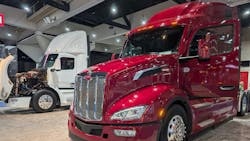Freight recession survival: How fleets can cut costs and optimize operations
Key takeaways
- Fleets face rising costs and shrinking margins, forcing deeper cost cuts and smarter operational decisions to survive.
- AI tools are shifting from innovation to necessity, helping fleets cut waste, improve fuel use, and extend asset life.
- OEMs are boosting diesel efficiency while fleets balance compliance, renewable fuels, and equipment upgrades amid uncertainty.
In years past, the American Trucking Associations’ fall management conference has served as a launching pad for fleets to fine-tune their growth strategies going into the following year. The 2025 ATA gathering was more like a high-level strategy meeting for motor carrier survival.
Rebecca Brewster, the American Trucking Research Institute president, captured the industry’s mood—and its crisis—starkly:
“Costs continue to go up. Rates are down. Fleets aren’t making money,” Brewster told me during a Fleet Lead podcast interview on the expo floor in San Diego last week.
Across every interview, press conference, and panel throughout the five-day event, powerful forces ruled: the punishing reality of the most prolonged freight recession in history amid unprecedented political and regulatory environments, and the industry’s manufacturers and suppliers pushing new technologies to increase efficiency and survive the downturn.
Chris Spear, ATA’s chief executive, underlined the political stakes: “With more than three decades in government relations, I have never witnessed anything close to what we’re navigating right now,” Spear said during his annual state of the industry address during the conference.
For the motor carrier executive, this uncertainty translates into painful, existential questions. Andy Owens, CEO of A&M Transport, captured the severity of the fleet-level decisions:
“We’re having to make some pretty hard decisions right now, tough staffing decisions,” Owens told me. “One thing I do know is you can’t take compensation away from drivers. I’ve heard some carriers have tried to do that, and that’s a death wish, right there, in my opinion. So, you’ve got to look for other ways to cut corners.”
Finding operational savings without sacrificing safety and efficiency is nothing new in an industry that operates on thin margins in good times. But it is during the bad times where every decision—good and bad—feels magnified.
Here are four overarching themes that kept coming up during my conversations in San Diego with carriers, suppliers, industry analysts, and drivers: the crisis driving up costs and the innovative solutions being deployed to address it.
Rising costs crisis and the elusive recovery are impacting more fleets
The grim economic reality was impossible to hide from at ATA. ACT Research analysts Tim Denoyer and Carter Vieth are no longer expecting freight recovery until later next year. This uncertainty, which ATA economist Bob Costello called the “new curse word,” is hitting carriers hard where it hurts most: the balance sheet.
ATRI’s cost data cited by Brewster showed that non-fuel operational costs have soared to $1.78 per mile. For many dry van carriers, this translates into negative profit margins. Compounding this pain are spiraling insurance costs driven by nuclear verdicts and potential high-impact tariffs on heavy-duty tractors imported from Mexico, which ACT estimates will result in five-figure price increases on new equipment. The cost of doing business is simply outpacing revenue, forcing carriers to defer maintenance and make cuts to stay afloat.
AI technology is creating a case for helping fleets survive
With rates flat and costs soaring, technology has shifted from a tool for future efficiency to a potential survival solution. But it can be challenging for fleets to decide what to invest in now when cash flow is low, particularly when it seemed like every supplier with a booth on the expo floor was touting its artificial intelligence as the key to survival.
While artificial intelligence might be the second most-uttered term behind uncertainty in 2025, emerging tools can help fleets address the rising cost-per-mile crisis. BeyondTrucks showcased a solution developed in Silicon Valley to reduce the $150 billion to $200 billion in annual waste from poor load planning and utilization.
Penske’s AI-powered Catalyst platform shows how focusing on simple KPIs—reducing idling, improving maintenance adherence, aero packages—yields immediate results. AI is helping dispatchers make real-time, data-driven decisions that cut waste, transforming technology from a strategic asset into a literal lifeline.
More than a year after rolling out its AI offering, Penske customers are not only gaining insights from Catalyst to compare with similar carriers but are also finding savings. Samantha Thompson, Penske’s VP of customer success and telematics, explained how AI highlights the critical financial links between operations and preventive maintenance:
“PMs aren’t just about making sure your vehicles are tick tock shape; it also impacts how well you’re utilizing fuel,” Thompson told me. “Also, if you don’t stay on top of your PMs, you can end up with unplanned repairs, which will ultimately impact your utilization. So these things are interconnected.”
Penske’s data showed that 67% of its fleet customers saw improvements across all AI-tracked KPIs, with 50% achieving a 5% increase in fuel efficiency after one month.
OEM response: Efficiency in diesel is creating more cost-saving opportunities
After years of focusing on battery-electric powertrain technology, this year’s ATA returned to trucking’s diesel-powered roots, with companies such as Volvo Trucks and Mack Trucks highlighting their newest redesigned tractors that offer more fuel efficiency and safety compared to previous models.
And while analysts are forecasting fewer Class 8 truck sales in 2026, OEMs are still reminding fleets that new equipment can yield significant savings with more efficient trucks.
“If you look today at what the return on sales of larger transport companies is, we’re talking 2, 3, 4% ... If you save 10% on fuel, your profits could go from 3% to 6%,” Peter Voorhoeve, president of Volvo Trucks North America, told me.
While it feels like the freight recession is continuously “two quarters away from ending,” it will end at some point. And the fleets that are ready to capitalize will win. “The market turns on a dime,” Jake White, Peterbilt’s director of product marketing, told me in San Diego. “That’s what happens. And I’d say, from a fleet perspective, the key thing is to ensure your fleet age is in a good place, and continue replacing trucks on the right cycles. Obviously, moderate your business, but the new trucks are achieving great fuel economy.”
Regulatory headwinds and pragmatic shifts are giving fleets a little breathing room
While EVs might one day be a bigger part of the U.S. trucking industry—and the economy as a whole—ATA members are focused on pragmatic goals rather than fanciful ideas from non-industry regulators who don’t understand the efficiency of diesel or the complexity of transitioning the long-haul industry to zero-emission solutions.
Of course, EPA ’27 emissions regulations still loom, with OEMs building for compliance despite limited fleet capital for pre-buys. The most significant practical shift, however, was the growing interest in alternatives such as renewable diesel. Carriers operating in highly regulated regions (California) see renewable diesel as the most cost-effective and immediately implementable pathway to carbon reduction, avoiding the monumental infrastructure costs and range issues that continue to plague heavy-duty EV adoption.
About the Author
Josh Fisher
Editor-in-Chief
Editor-in-Chief Josh Fisher has been with FleetOwner since 2017. He covers everything from modern fleet management to operational efficiency, artificial intelligence, autonomous trucking, alternative fuels and powertrains, regulations, and emerging transportation technology. Based in Maryland, he writes the Lane Shift Ahead column about the changing North American transportation landscape.



